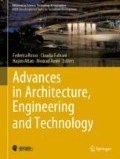Abstract
In recent years, interest has increased in water and its preservation alongside environmental effects. Previously, the focus was on the geographical and health importance of water, but recent studies have discussed the use of water in architectural design and its effects on architectural spaces as well as its environmental effects on architecture. Some studies have examined the psychological impact of water properties on specific areas. The current research investigates the psychological impact of water on the visitors and determines the aspects of water and their effects on the users of architectural spaces to specify positive impact of water in order to utilize them in architectural design. Theoretical results of the current study were then applied in the form of a questionnaire to define the importance of an artificial waterfall in a park and its psychological effects on visitors.
Access this chapter
Tax calculation will be finalised at checkout
Purchases are for personal use only
Notes
- 1.
Feng Shui is the Chinese art of design and placement. Chinese people thought that humans inhabit an energy filed. Feng Shui is concerned with the study of this fundamental energy. It is the basic comprehension of energy, in regard to its flow, manners and pattern, in a certain space.
- 2.
References
Asakawa, S., Yoshida, K., & Yabe, K. (2004). Perceptions of Urban Stream Corridors within the Greenway System of Sapporo, Japan. Landscape and Urban Planning, 68(2–3), 167–182.
Burmil, S., Daniel, T. C., & Hetherington, J. D. (1999). Human Values and Perceptions of Water in Arid Landscapes. Landscape and Urban Planning, 44(2–3), 99–109.
Burton Litton. (1974). Water and Landscape: An Aesthetic Overview of the Role of Water in the Landscape.
Coeterier, J. F. (1996). Dominant Attributes in the Perception and Evaluation of the Dutch Landscape. Landscape and Urban Planning, 34, 27–44.
Dreiseitl, H, and D Grau. (2005). New Waterscapes: Planning, Building and Designing with Water. Birkhäuser. https://books.google.com.tr/books?id=U6uKAQAACAAJ.
Felsten, G. (2009). Where to Take a Study Break on the College Campus: An Attention Restoration Theory Perspective. Journal of Environmental Psychology, 29(1), 160–167. https://doi.org/10.1016/j.jenvp.2008.11.006
Hedgcock, D., & Mike, M. (1993). WATER SENSITIVE RESIDENTIAL DESIGN. Australian Planner, 31(2), 114–118. https://doi.org/10.1080/07293682.1993.9657618
Herzog, Thomas R., Eugene J. Herbert, Rachel Kaplan, and C. L. Crooks. (2000). “Cultural and Developmental Comparisons of Landscape Perceptions and Preferences.” Environment and Behavior 32(3): 323–46. http://journals.sagepub.com/doi/https://doi.org/10.1177/0013916500323002.
Howley, P. (2011). Landscape Aesthetics: Assessing the General Publics’ Preferences towards Rural Landscapes. Ecological Economics, 72, 161–169. https://doi.org/10.1016/j.ecolecon.2011.09.026
Kaplan, Rachel. (1977). “Down by the Riverside: Informational Factors in Waterscape Preference.” In: Proceedings on the Symposium on River Recreation Management and Research USDA Fores: 285–89.
Karmanov, D., & Hamel, R. (2008). Assessing the Restorative Potential of Contemporary Urban Environment(s): Beyond the Nature versus Urban Dichotomy. Landscape and Urban Planning, 86(2), 115–125.
Laumann, K., Gärling, T., & Stormark, K. M. (2001). Rating Scale Measures of Restorative Components of Environments. Journal of Environmental Psychology, 21(1), 31–44.
Lifang, Qiao, Zhang Yichuan, and Cao Wei. (2008). “Evaluation of Urban River Landscape Design Rationality Based on AHP.” Water Science and Engineering 1(4): 75–81. http://www.sciencedirect.com/science/article/pii/S1674237015300417.
Litton, R B. (1974). Water and Landscape: An Aesthetic Overview of the Role of Water in the Landscape. Water Information Center, Incorporated.
Nasar, J. L. (1990). The Evaluative Image of the City. Journal of the American Planning Association, 56(1), 41–53.
Nasar, J. L., & Li, M. (2003). Landscape Mirror: The Attractiveness of Reflecting Water. Landscape and Urban Planning, 66(4), 233–238.
Plumptre, G. (1993). The Water Garden: Styles. Thames & Hudson.
Program, Environmental Studies, and L Fredrickson. (1999). “A Qualitative Exploration of the Wilderness Experience As a Source of Spiritual Inspiration.” Journal of Environmental Psychology 19(1): 21–39. http://linkinghub.elsevier.com/retrieve/pii/S0272494498901104.
SEÇKİN, Yasin Çağatay. (2010). “Understanding the Relationship between Human Needs and the Use of Water in Landscape Design.” : 1–17.
Smith, D. G., Croker, G. F., & McFarlane, K. (1995). Human Perception of Water Appearance: 1. Clarity and Colour for Bathing and Aesthetics. New Zealand Journal of Marine and Freshwater Research, 29(1), 29–43.
Steinwender, A., Gundacker, C., & Wittmann, K. J. (2008). Objective versus Subjective Assessments of Environmental Quality of Standing and Running Waters in a Large City. Landscape and Urban Planning, 84(2), 116–126.
Symmes, M F, K A Breisch, S Astley, and Cooper-Hewitt Museum. (1998). Fountains: Splash and Spectacle : Water and Design from the Renaissance to the Present. Thames and Hudson. https://books.google.com.tr/books?id=O2VvQgAACAAJ.
Vernon, B., & Tiwari, R. (2009). Place-Making through Water Sensitive Urban Design. Sustainability, 1(4), 789–814.
Völker, S., & Kistemann, T. (2011). The Impact of Blue Space on Human Health and Well-Being - Salutogenetic Health Effects of Inland Surface Waters: A Review. International Journal of Hygiene and Environmental Health, 214(6), 449–460.
Whalley, J. (1988). Water in the Landscape. Landscape and Urban Planning, 16(1–2), 145–162.
White, M., et al. (2010). Blue Space: The Importance of Water for Preference, Affect, and Restorativeness Ratings of Natural and Built Scenes. Journal of Environmental Psychology, 30(4), 482–493. https://doi.org/10.1016/j.jenvp.2010.04.004
Yamashita, S. (2002). Perception and Evaluation of Water in Landscape: Use of Photo-Projective Method to Compare Child and Adult Residents’ Perceptions of a Japanese River Environment. Landscape and Urban Planning, 62(1), 3–17.
Acknowledgements
This research was supported by College of Engineering—Mosul University/ Mosul, Iraq and College of Engineering Mustansiriyah University/ Baghdad, Iraq.
Also, thanks to Assistant Professor Dr. Ozlem Mumcu Ucar / Eskişehir Technical University, Faculty of Architecture and Design.
Author information
Authors and Affiliations
Corresponding author
Editor information
Editors and Affiliations
Rights and permissions
Copyright information
© 2022 The Author(s), under exclusive license to Springer Nature Switzerland AG
About this paper
Cite this paper
Mahmoud, K.F., Al-Bakry, H.M.J., Al-Tuhafi, A.AH. (2022). Water as an Element of Architectural Space Design Study the Psychological Impact of Water on the Occupants of the Space. In: Rosso, F., Fabiani, C., Altan, H., Amer, M. (eds) Advances in Architecture, Engineering and Technology. Advances in Science, Technology & Innovation. Springer, Cham. https://doi.org/10.1007/978-3-030-86913-7_8
Download citation
DOI: https://doi.org/10.1007/978-3-030-86913-7_8
Published:
Publisher Name: Springer, Cham
Print ISBN: 978-3-030-86912-0
Online ISBN: 978-3-030-86913-7
eBook Packages: Earth and Environmental ScienceEarth and Environmental Science (R0)

